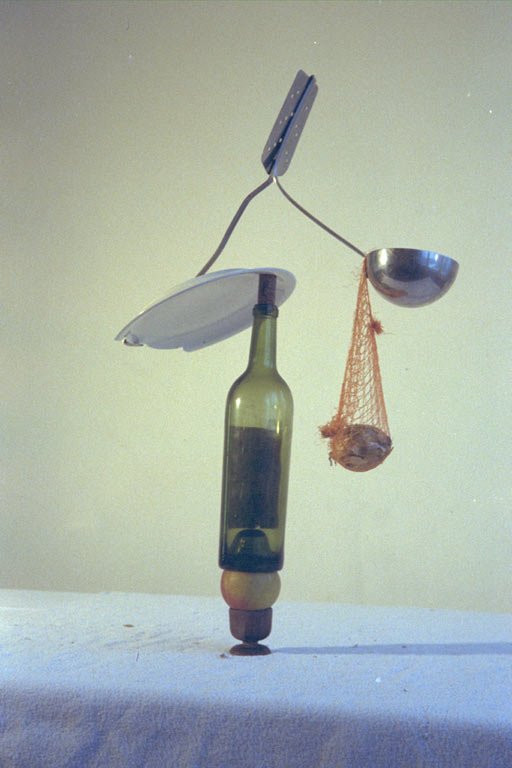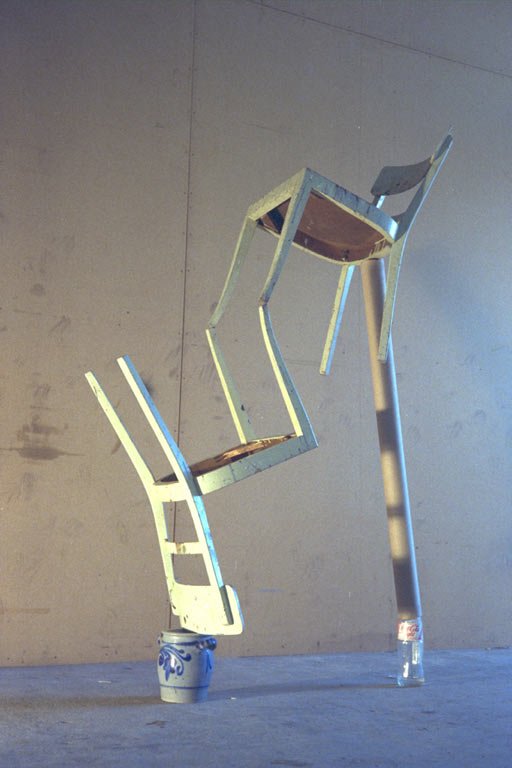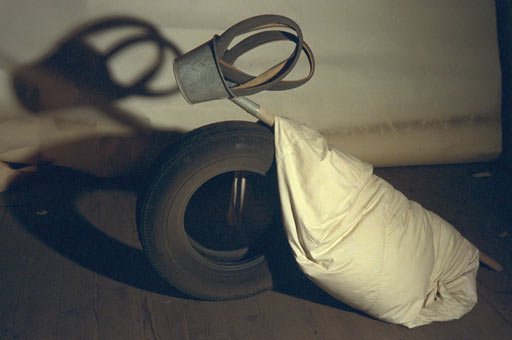22nd February 2020
Everyday life throws up many unlikely juxtapositions and symbols. Research online Peter Fischli and David Weiss ‘Quiet Afternoon’ series and have a look at their amusing video ‘The Way Things Go.’
OCA Foundations IN PHOTOGRAPHY COURSE FOLDER PG127
Artists information from The Tate website:
The photographs which make up the series Equilibres / Quiet Afternoon 1984 show precariously balanced sculptures at what appears to be the exact moment before their collapse. Perhaps not such a quiet afternoon then. Everyday items such as vegetables, kitchen utensils, tyres, chairs, and tools, are piled in elaborate configurations that – for an instant, at least – appear stable. ‘We discovered that we could leave all formal decisions to equilibrium itself’, Fischli has said of these sculptures. ‘There was apparently no way to do it ‘better’ or ‘worse’, just ‘correctly’.’
Tate tate.org.uk
Below are three images of still-life photography by Fischli and Weiss from The Tate website.

Image from Tate tate.org.uk

Image from Tate tate.org.uk

Image from Tate tate.org.uk
Another very good visual resource with many examples of their work is the HIC website, hicarquitectura.com I particularly like this page because, unlike some of the other websites they have the titles of the photographs with each image.
The below video shows some of the ‘Equilibres / Quiet Afternoon’ works in exhibition and gives a simple and quick introduction to the works. The video is taken from YouTube and was uploaded by Museo Jumex, 2016.
The work, ‘Equilibres’ takes its name from the way the chosen objects are physically balanced and composed with each other. Objects used were everyday household and industrial items which were on hand, for example, chairs, tyres, cups, bottles, vases, string, balloons, brooms and even food, for example apples. The images are produced in colour and black and white.
These objects were then placed on various plinths, bases, studio corners or within environments such as doorways and they would then often use lighting to convey a sense of abstraction. This abstraction would be able to be seen in lines and shapes as well as the shadows which the lights would cast.
The subtitle, ‘Quiet Afternoon’ came about because the duo wanted to put themselves into a state of boredom which would, hopefully give their minds blank slates on which to work, which would allow them to produce sculptures instinctively rather than intentionally and was meant to be fun and playful.
To add to their concepts of boredom and free thinking construction, balance, use of space, shape and line, Fischli and Weiss used humour. The humour can be seen in their instinctive constructions which are made stronger by the use of well chosen titles.
The titles give the viewer a hint to the constructed sculptures representation and/or provide us with a narrative on which to ponder.
Titles such as:



image taken from CHRISTIE’S Christies.com
On looking at Fischli and Weiss’s work, I thought of the children’s game ‘Buckeroo’ and the ‘Kinetic’ art movement. The reason I thought about these two things is because in the Buckeroo we try to balance an odd assortment of plastic objects onto a donkey hoping that it does not buck the objects off. Where as the Kinetic movement, although they were primarily connected with optical illusions and movement, they too produced sculptures, although sometimes far more complexed, which have shape, lines and shadows which remind me of the work, ‘Equilibres’ by Fischli and Weiss.
The above sculpture is seen as the first piece of kinetic art, however the objects also connect with the work of Fischli and Weiss. Image from intlkineticartevent.org

Image from metmuseum.org
Following on from the Equilibres series was the duo’s film, ‘The Way Things Go.’ I found it quite interesting that the film actually does rely on the movement and subsequent interaction of objects against one another so in fact their work now takes on a very Kinetic theme and feel to it. The objects moving and the types of movement and objects used also reminds me of the children’s ‘Mousetrap’ game.
It was actually very entertaining and mesmerising watching the videos and the objects moving, tumbling and touching each other through the use of force. it reminded me of the elaborate domino tracks we use to make as kids that would knock over objects we put in their way which in turn would fall or spin and begin knocking more dominos on the track down.
The Way Things go also reminds me of Rube Goldberg Machines which are also constructed out of everyday objects but unlike Fischli and Weiss’s work which looks unkempt, unsightly, trash put together, Goldberg’s machines look elaborate and new and attractive to the eye, in fact the opposite to The Way Things Go constructions.
There isn’t anyone on the planet who can deny the pleasure of watching a good Rube Goldberg machine. For those of you who don’t know, Rube Goldberg was an American cartoonist, often referred to as the “father of invention” for his series of comics depicting what we call Rube Goldberg machines: Complicated, deliberately overengineered contraptions that ultimately perform a very simple task. Ironically, they’re rarely (if ever) built by rubes. One step triggers the next in a chain reaction until the final task is complete. Once it starts, it’s practically impossible to peel yourself away from the anticipation of what’s coming next.
Will Nicol 2019, Digital Trends digitaltrends.com
See comparison below:
image from Digital Trends digitaltrends.com
I have found a series of small clips of a film on YouTube that shows the entire work in parts, this can be seen below. I have found it fascinating watching their kinetic work which is a mixture between, art and film and physics. I also keep thinking of all those films I have watched in the past or comic strips where children and others (adults, aliens etc…) have set up circuits like these as elaborate traps for someone or something to get caught in.
My final thoughts on these still life’s are ‘OK!’ For me I have to go beyond looking at the physics involved or the humour but take in the shapes, lines and colours of the objects and how they relate to each other and to their shadows. Even looking at parts of the ‘sculptures’ becomes interesting and abstract as well as taking into account the importance of the negative spaces and their shapes and lines also.




Leave a comment